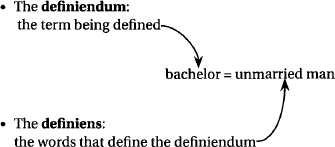CHAPTER 3
DEFINITIONS
Definitions are very useful in explaining and clarifying meaning. A typical definition has two parts:

People often use is instead of the equality sign in giving definitions—for example, a bachelor is an unmarried man. A bit more terminology:
- A term is a referring expression in a language made up of one or more words, such as The United Nations, Beethoven, mammals, purple.
- The referent of a term is what the term refers to. So the terms listed in the last paragraph refer respectively to an organization, a person, a class of animals, and a particular shade of color. A term such as Mount Everest refers to a real physical thing in the world, but other terms such as truth and 13467 refer to more abstract things. The set of things a term refers to is known as the extension of the term. So dolphins, humans, donkeys, gorillas are all within the extension of mammals.
- The concept associated with a term is an idea that encapsulates our under standing of the term. Although a term is made up of words, a concept is not. Agua is a Spanish word distinct from the English word water. They have different spelling and pronunciation, but they have the same meaning and express the same concept.
In this book we shall take definitions to be primarily definitions of terms, although we can loosely speak of defining a concept (that is, defining the term that expresses the concept). ...

